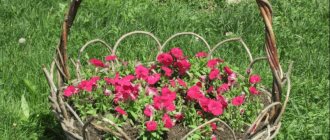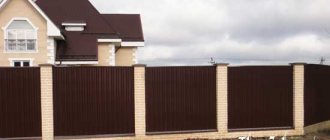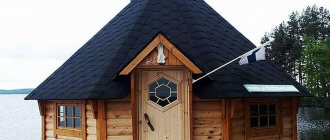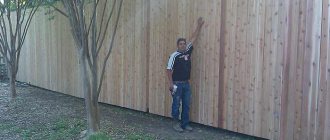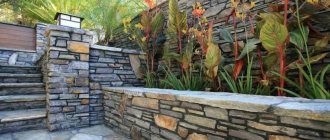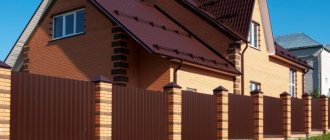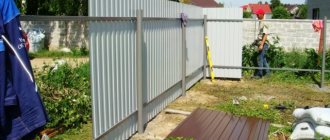Some compare wrought iron fences and gates to works of art in their beauty. However, these elements are not only distinguished by their attractive appearance, but also by their reliability and practicality. Such a fence will last as long as possible and reliably protect the house. Of course, the manufacture and installation of a metal fence requires certain financial costs, but the result is undoubtedly worth it.
Gates and wicket in brick frame
What kind of forging is there?
Depending on the method of creation, it happens:
- Stamped. Done in production. It is an automated process for manufacturing metal elements. You can buy ready-made identical fence sections and install them yourself. Much cheaper than a manual one, but such a fence will not be unique.
- Manual. Performed using hot or cold technology. Each forged element is unique. Masters create custom-made entire paintings that can tell about the tastes and hobbies of the owners of the site. The process is labor-intensive and time-consuming. Ready-made handmade sectional canvases are an expensive pleasure.
Let us examine in more detail the production of parts using hot and cold forging.
hot
Photo: hot forging using hand tools
The metal workpiece is heated to the required temperature so that it becomes soft and plastic. Next, the craftsman uses a hammer, anvil or hydraulic press to shape the part and cool it in cold water.
This is how exclusive architectural elements, artistic ornaments and designs are obtained. To speed up the work, many craftsmen purchase equipment that practically does not require forging by hand.
Cold
Not so popular. The workpieces are processed without heating. The shape of the metal is changed using a press and then annealed. Mainly used in the serial production of parts and gratings using welding. The elements turn out beautiful, but not elite. But for a country fencing, this is a good and inexpensive option.
Photo: cold forging using a bending machine
Decor
Forging as a craft appeared back in the 6th century BC. It transformed into art only as metal processing technologies modernized. By the 18th century, blacksmiths learned to create elegant, subtle decorative elements from metal. over time, the patterns became even more varied and bold in shape. Each era has its own forging design. For example, during the Renaissance, decorative elements and complex patterns became popular, which were further developed in the Baroque style.
Today, forged flowers, all kinds of ornaments, intricate snails and curls are an integral part of forging as an art, which is reflected in the manufacture of a wide variety of elements and structures. Forged fences are the most prominent representative among them. For everyone, a custom-made forged fence with an original design solution will become something unusual, like an exhibit from a museum, which you don’t need to buy a ticket to admire.
Forged fences, in addition to the design, may differ from each other and in color. The quality of the paint used will determine how long the fence will remain in its original form and how often it will need to be repainted. The color palette for metal fences today has a wide range. You can choose exactly the shade that will allow the fence to fit into the overall concept of landscape design in the most advantageous way.
Note: there is no need to paint the fence black or brown. These can be light shades that will give the design lightness and grace. A certain shade of green will resemble an oxidized dose.
The nobility of the structure can be achieved by patination of the spans. This technique looks bright if artistic forging is used on custom-made fences.
Landscape designers often use a combination of brick and metal. Decorative spans of metal with forged elements around a classic front garden will help give the composition uniqueness and a special atmosphere. Actually, the right combination of cold metal and natural greenery in itself looks like an excellent aesthetic device even for a fairly inexpensive enclosing structure, while at the same time solving a large number of functional problems that are associated with the isolation of the territory bordered by this fence.
A hedge along a wrought-iron fence or climbing vegetation entwining an iron lattice will help emphasize the special attractiveness of a house or site. Street lights will add a decorative finish to the wrought iron fence. A fence using cast elements will become a real work of art. The entire territory of the site takes on a majestic appearance. Achieving such an effect costs a lot of money, but as they say, “beauty requires sacrifice.”
Where is it used?
Forging is widely used both in the exterior decoration of buildings and in interior design. Most often they decorate with forging parts:
- stairs;
- gazebos;
- fences, gates, gates;
- verandas, terraces;
- awnings;
- window and door openings;
- balconies;
- railings;
- fireplaces;
- chandeliers;
- dishes, vases, candlesticks;
- arches;
- barbecues;
- swings and more.
Photo: forging samples
Elements in the form of tips and peaks are used to decorate the top of fences to give them a finished look. Monograms, currency, and balusters are used to decorate stair railings, fireplace grates, and gates. Metal plants will beautifully complement a summer gazebo or balcony lattice.
Wrought iron goes well with wood, polycarbonate, corrugated sheets, and steel, so many owners try to combine several types of materials when building fences.
Thematic material:
- Metal picket fence
- Wrought iron fence with polycarbonate
Ancient craft
Blacksmithing in Rus' is an ancient craft. Not a single peasant family in former times could do without a plow, harrow, sickle, ax and other items necessary for peasant labor and life. They were forged by blacksmiths.
Today, craftsmen forge not scythes and axes from metal, but much more elegant things.
Nowadays, wrought-iron fences are becoming increasingly popular among homestead owners. They are installed around country houses and cottages, and enclose the territory of parks and squares. Such designs speak of the excellent taste and merits of the owner.
Classification by manufacturing technology
Fences are made in three ways:
- Connecting elements by welding. The cheapest option. A welded structure is not a work of art, but the fence will be reliable and neat.
Photo: assembly and welding of forged elements into a single structure - Artistic (hot) forging. Allows you to create different patterns based on pre-made sketches. The master does everything by hand.
- Forged-welded method. They take ready-made strips and rods, give them the required shape and weld the parts to each other.
More often they make fences using the third method. By purchasing ready-made sections, owners significantly reduce costs and time for building a fence.
Types of structures
There are:
- Fences mounted as separate spans and supported on brick or stone supports. The pillars are connected by a ribbon-shaped plinth 15–100 cm high. An option without it is possible.
- Solid fence fabric. The racks are steel pipes. With the correct diameter, the structure has a holistic appearance.
- Fences with a fixed screen, on which forged parts stand out. Thin iron sheets, cellular polycarbonate, and corrugated sheets are used as a shielding surface. Often this is how a wicket or gate is designed to shade the yard and provide reliable protection from strangers.
Photo: stylish fencing of the local area
To make the estate closed and not visible from the street side, you should choose a screened fence.
Let's look at the design of other options for wrought metal fences.
Decorative (low)
They are used to decorate the area, not to protect it. Have artistic elements. They protect flower beds, garden areas, and the area behind the house. They are made low - up to 1 m. They look elegant. They are painted in different colors. Made to order.
Photo: combination of stone and metal in the fencing of the site
Protective (functional)
Factory imitation of artistic forging, obtained by stamping. Implemented in sections. Popular types of pillars are brick and metal. This type of fence is used to enclose private properties, cottages, dachas, and parks. They often have a minimum of decorative elements. Very durable, they serve as reliable protection for the area. The price is affordable.
Combined
This structure combines elements of the first two types. The welded fence is complemented by simple forged parts. A screen made of polycarbonate and corrugated sheets is installed in the background. Standard parts are produced in the factory by stamping. This type of fence is reliable, has average prices, and has an attractive appearance.
Photo: the wrought-iron fence is complemented with profile sheets hiding the garden area from prying eyes
In the private sector, a wicket or gate for a wrought iron fence is often designed using a combination of materials.
Set for work
- Welding machine with a set of electrodes.
- Grinder with grinding and cutting discs.
- Equipment for the production of decorative elements. There are several types of machines that allow you to give metal rods different shapes. You will learn more about the main units below.
- Vise. A flimsy student setup won't do. You need a powerful locksmith unit. Additionally, prepare patterned yews to give the rods a spiral shape.
- Pliers.
- Roulette.
- Hammer.
- Building level.
- Corner.
- A spray bottle or several brushes of different sizes.
- Steel rods with a diameter of 12-14 mm.
- Sheet steel 2 mm thick. We will use it to make peak tips. We buy the material if peaks are present in the selected fencing design.
Elements of a wrought iron fence
Photos of artistic forging
Advantages and disadvantages
Advantages of a wrought iron fence:
- Strength. The reliability of metal cannot be compared with wood or plastic. Forging can withstand any load and is resistant to mechanical damage.
- Durability. The service life of such fences can reach one hundred years. It is not for nothing that many historical architectural monuments that have survived to this day have forged parts. An important condition for long-term operation is high-quality anti-corrosion treatment.
- Does not require special care.
- Can be repaired without harm to the entire structure.
- Beautiful patterns and ornaments look very expensive and elegant.
- Safety guarantee. Metal structures can be classified as burglar-resistant. They are difficult to overcome, especially if the top of the fence is decorated with sharp peaks or tips.
- Wide selection of design styles. To install budget fencing, buy ready-made sections. To get a unique structure, you should develop your own sketch and order forging from a master.
The following should be said about the disadvantages:
- The price of artistic forging of individual fence models can reach 50,000 rubles. for 1 square meter.
- The heavy weight of the structures complicates their transportation and installation.
- To install such a fence yourself, you need experience in construction.
- Fencing without shielding is almost transparent. Therefore, everything that happens on the site will be clearly visible from the street.
- Once every 3-4 years it is recommended to treat the metal surface against corrosion. This way it will last even longer.
If this is your first time encountering the process of building a fence, then it is better not to experiment with self-installation, but to order the services of craftsmen.
Recommendations from experts
When drawing up a sketch and drawing of a future forged fence, it is necessary to maintain a balance between functionality, aesthetics and financial costs for its production. A sectional fence can be tightly closed with wood or made on the basis of a metal profile, and forged elements will make the structure more expensive and impressive. When making such a fence you will not have to spend a lot of money, and installing a foundation will also save money.
In addition, when ordering a wrought iron fence, you need to take into account a number of important points:
- The density of the fence pattern ultimately determines its strength. The more often forged patterns are installed, the stronger the fence will be;
- The components of the entire fence are connected by welding using clamps. The quality of the welds is important: they must be smooth and invisible;
- At the design stage of the future wrought iron fence, it is necessary to plan the design of the gate: will it be swinging or sliding, or maybe folding;
- You should also plan the execution of the wicket;
- The pattern on the fence, gate and gate must be repeated;
- A wrought iron fence should not be located closer than one or one and a half meters from the roadway. Otherwise, water and dirt from under the wheels of passing vehicles will fly directly onto the fence and it will quickly rust.
Schemes and drawings of finished structures in different styles
To implement any of the patterns in practice, it is necessary to develop a sketch of the future section in advance. The drawing is selected based on the preferences of the owners and the design style of the structure.
Photo: various options for fence sections
There are plenty of forging styles to choose from. Let's look at the main features of the most popular of them. This:
- Russian. Convex shaped elements are used. Patterns are created with natural motifs.
- Russian-Byzantine. Very similar to the previous one. The parts also have a convex shape. Decorated with floral ornaments. But the main difference is that the composition is complemented by geometric shapes.
- Baroque. The fence is full of small patterned details. They can be flowers, baskets, crowns, figurines, ornate ornaments. All these elements create an overall picture of luxury and sophistication.
- Gothic. The fence turns out to be an elongated shape, directed towards the sky. Often the main detail is a pointed arched structure, which looks very impressive.
- Rococo. It acts as a continuation of the Baroque, but it has much fewer small details. The main emphasis of the style is elegance.
- Modern. Forging is full of abstract elements, evenly or unevenly spaced curved lines.
The style of the fence should be chosen in accordance with the overall picture of the architectural structures on the estate, so that it is in harmony with the entire composition.
Popular manufacturers of forged fencing
There are a number of manufacturing companies on the domestic construction market that have won trust with good quality and reasonable prices. Let us highlight the main ones.
Kovart
Experience in the field of creating forged products – 17 years. The skills of designers and craftsmen allow the use of artistic techniques that were used by blacksmiths in tsarist times.
The company provides the following services:
- creation of drawing projects to order;
- shot blasting of metal;
- 3D modeling;
- laser cutting;
- artistic patination - application of silver, copper, gold;
- chrome plating;
- coating of forged products with gold by electroplating.
Photo: elite product made
The list of products includes elements of interior decoration of premises and details for the exterior design of buildings and fences.
KovArt also puts into practice designs proposed by clients.
First Forging Factory
A Moscow enterprise that makes jewelry and metal products using artistic or stamped methods. The warranty for all products is 5 years.
Located 15 km from the Moscow Ring Road on the Minsk Highway.
Rowand forging
The domestic company was founded in 1997. Manufactures welded and forged structures of varying complexity and sizes:
- gates,
- railings,
- visors,
- ritual fences,
- furniture,
- fence sections and more.
Takes on any volume of work ordered.
Kreitmet
Russian plant. Mainly produces plastic, metal-plastic, forged products.
The technical capacity of Kreitmet allows us to produce up to 200 tons of metal structures per month.
Among the products:
- fences made of square and round profiles;
- swing and sliding forged and welded gates;
- forged, welded grilles for windows;
- railings;
- flower stands, stands;
- visors;
- chandeliers, sconces
In addition to producing custom goods, a team of craftsmen also performs installation work.
Insight
The plant is engaged in artistic forging. It has production workshops in Moscow, Voronezh, and St. Petersburg. Produces decorative elements, fences, furniture, lanterns and more. Designers will help you develop a design sketch based on the client’s idea or an individual project.
Construction of a forged fence from ready-made sections
If you have welding skills, you can try to make fence bars yourself by decorating the rods with elements using the cold forging method. But this process is labor-intensive and time-consuming. It's easier to install the factory sections yourself.
Required materials and tools
To install the fence you need:
- wooden pegs, rope;
- level;
- shovel or drill;
- roulette;
- plumb line;
- grinder with a metal disc;
- welding machine, mask, electrodes;
- cement, sand, crushed stone;
- material for pillars;
- hammer, file;
- anti-corrosion primer;
- dye;
- spray bottle, brush.
The area is cleared of vegetation and debris. Markings are made along the perimeter of the future fence. In the places of the posts, pegs are driven in at 2.5 m intervals, and a rope is stretched between them.
Foundation arrangement
There are several options for a base for a forged structure:
- Pouring a monolithic concrete strip.
- Column and point foundations for each rack.
- Pile-screw (on marshy soils).
The first two are most often used. Under massive fences with brick and stone pillars, a tape is poured; under lightweight fences, a columnar foundation is poured.
Let's look at the main stages of creating these foundations.
Columnar
Concreting of each support is carried out separately in a pre-prepared well.
The work order is as follows:
- Holes are dug or drilled under the pillars to a depth of 0.7–1.5 m. The recommended depth is at least ⅓ of the height of the future support. Diameter 25–30 cm.
- The bottom is compacted. A metal stand is placed into the well at a level. Another option is to fix pieces of asbestos-cement pipes in the wells so that their height looks 10–15 cm above the ground. The empty space around is filled with crushed stone and liquid concrete mortar. The metal stand is fixed at the top.
Builders do not recommend completely concreting the pillar until a section of the fence is welded to it, since if you miscalculate the spacing between the supports by even a centimeter, it is unlikely that the spans will be accurately secured.

